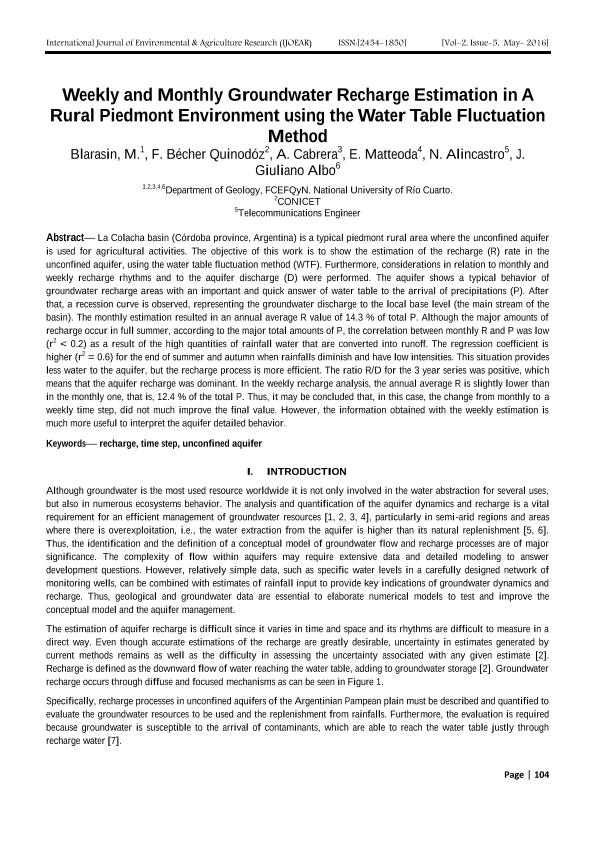Mostrar el registro sencillo del ítem
dc.contributor.author
Blarasin, Mónica Teresa

dc.contributor.author
Bécher Quinodóz, Fátima Noelia

dc.contributor.author
Cabrera, Adriana Edith

dc.contributor.author
Matteoda, Edel Mara

dc.contributor.author
Alincastro, Nahuel

dc.contributor.author
Giuliano Albo, María Jesica

dc.date.available
2022-12-02T19:07:44Z
dc.date.issued
2016-05
dc.identifier.citation
Blarasin, Mónica Teresa; Bécher Quinodóz, Fátima Noelia; Cabrera, Adriana Edith; Matteoda, Edel Mara; Alincastro, Nahuel; et al.; Weekly and Monthly Groundwater Recharge Estimation in A Rural Piedmont Environment using the Water Table Fluctuation Method; Mukesh Arora; International Journal of Environmental & Agriculture Research (IJOEAR); 2; 5-2016; 104-113
dc.identifier.issn
2454-1850
dc.identifier.uri
http://hdl.handle.net/11336/180062
dc.description.abstract
La Colacha basin (Córdoba province, Argentina) is a typical piedmont rural area where the unconfined aquifer is used for agricultural activities. The objective of this work is to show the estimation of the recharge (R) rate in the unconfined aquifer, using the water table fluctuation method (WTF). Furthermore, considerations in relation to monthly and weekly recharge rhythms and to the aquifer discharge (D) were performed. The aquifer shows a typical behavior of groundwater recharge areas with an important and quick answer of water table to the arrival of precipitations (P). After that, a recession curve is observed, representing the groundwater discharge to the local base level (the main stream of the basin). The monthly estimation resulted in an annual average R value of 14.3 % of total P. Although the major amounts of recharge occur in full summer, according to the major total amounts of P, the correlation between monthly R and P was low (r2 < 0.2) as a result of the high quantities of rainfall water that are converted into runoff. The regression coefficient is higher (r2 = 0.6) for the end of summer and autumn when rainfalls diminish and have low intensities. This situation provides less water to the aquifer, but the recharge process is more efficient. The ratio R/D for the 3 year series was positive, which means that the aquifer recharge was dominant. In the weekly recharge analysis, the annual average R is slightly lower than in the monthly one, that is, 12.4 % of the total P. Thus, it may be concluded that, in this case, the change from monthly to a weekly time step, did not much improve the final value. However, the information obtained with the weekly estimation is much more useful to interpret the aquifer detailed behavior.
dc.format
application/pdf
dc.language.iso
eng
dc.publisher
Mukesh Arora
dc.rights
info:eu-repo/semantics/openAccess
dc.rights.uri
https://creativecommons.org/licenses/by/2.5/ar/
dc.subject
RECHARGE
dc.subject
AQUIFER
dc.subject
WATER TABLE
dc.subject.classification
Oceanografía, Hidrología, Recursos Hídricos

dc.subject.classification
Ciencias de la Tierra y relacionadas con el Medio Ambiente

dc.subject.classification
CIENCIAS NATURALES Y EXACTAS

dc.title
Weekly and Monthly Groundwater Recharge Estimation in A Rural Piedmont Environment using the Water Table Fluctuation Method
dc.type
info:eu-repo/semantics/article
dc.type
info:ar-repo/semantics/artículo
dc.type
info:eu-repo/semantics/publishedVersion
dc.date.updated
2022-11-30T22:32:12Z
dc.journal.volume
2
dc.journal.pagination
104-113
dc.journal.pais
India

dc.description.fil
Fil: Blarasin, Mónica Teresa. Consejo Nacional de Investigaciones Científicas y Técnicas. Centro Científico Tecnológico Conicet - Córdoba; Argentina. Universidad Nacional de Río Cuarto. Facultad de Ciencias Exactas, Fisicoquímicas y Naturales. Departamento de Geología; Argentina
dc.description.fil
Fil: Bécher Quinodóz, Fátima Noelia. Universidad Nacional de Río Cuarto. Facultad de Ciencias Exactas, Fisicoquímicas y Naturales. Departamento de Geología; Argentina. Consejo Nacional de Investigaciones Científicas y Técnicas. Centro Científico Tecnológico Conicet - Córdoba; Argentina
dc.description.fil
Fil: Cabrera, Adriana Edith. Universidad Nacional de Río Cuarto. Facultad de Ciencias Exactas, Fisicoquímicas y Naturales. Departamento de Geología; Argentina. Consejo Nacional de Investigaciones Científicas y Técnicas. Centro Científico Tecnológico Conicet - Córdoba; Argentina
dc.description.fil
Fil: Matteoda, Edel Mara. Universidad Nacional de Río Cuarto. Facultad de Ciencias Exactas, Fisicoquímicas y Naturales. Departamento de Geología; Argentina. Consejo Nacional de Investigaciones Científicas y Técnicas. Centro Científico Tecnológico Conicet - Córdoba; Argentina
dc.description.fil
Fil: Alincastro, Nahuel. Universidad Nacional de Río Cuarto. Facultad de Ciencias Exactas, Fisicoquímicas y Naturales. Departamento de Geología; Argentina. Consejo Nacional de Investigaciones Científicas y Técnicas. Centro Científico Tecnológico Conicet - Córdoba; Argentina
dc.description.fil
Fil: Giuliano Albo, María Jesica. Universidad Nacional de Río Cuarto. Facultad de Ciencias Exactas, Fisicoquímicas y Naturales. Departamento de Geología; Argentina. Consejo Nacional de Investigaciones Científicas y Técnicas. Centro Científico Tecnológico Conicet - Córdoba; Argentina
dc.journal.title
International Journal of Environmental & Agriculture Research (IJOEAR)
dc.relation.alternativeid
info:eu-repo/semantics/altIdentifier/url/https://ijoear.com/issue-detail/issue-May-2016
Archivos asociados
